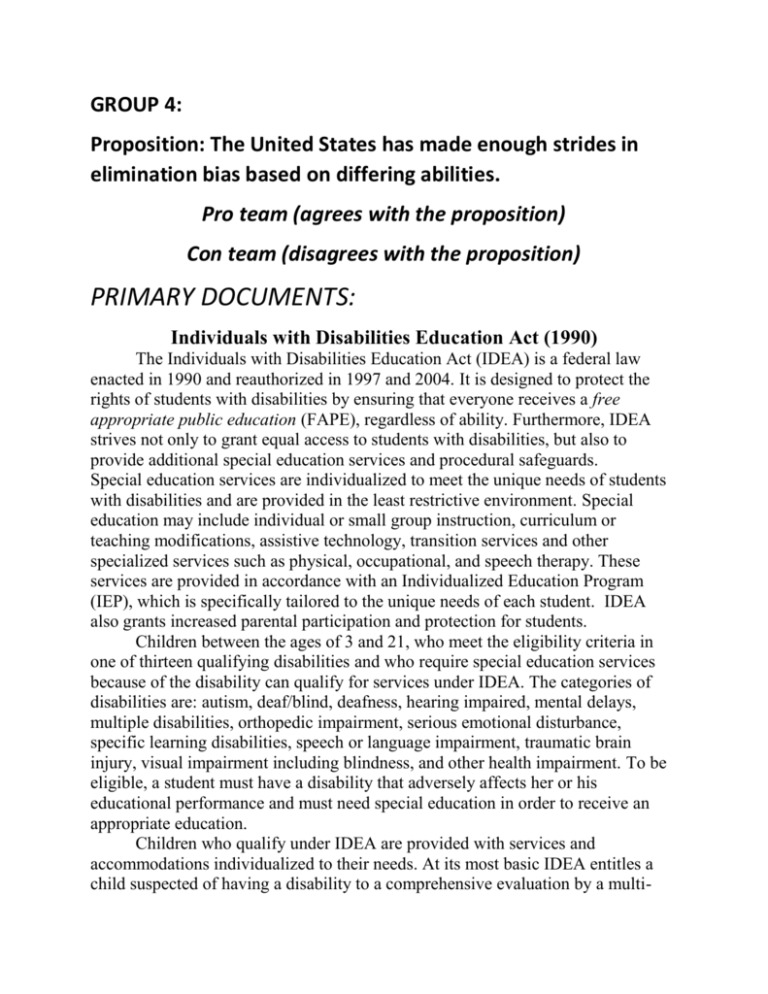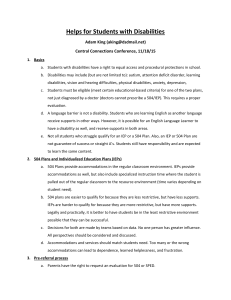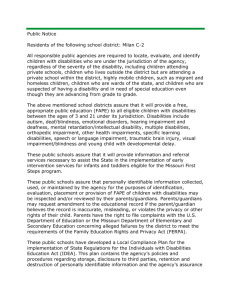GROUP 4
advertisement

GROUP 4: Proposition: The United States has made enough strides in elimination bias based on differing abilities. Pro team (agrees with the proposition) Con team (disagrees with the proposition) PRIMARY DOCUMENTS: Individuals with Disabilities Education Act (1990) The Individuals with Disabilities Education Act (IDEA) is a federal law enacted in 1990 and reauthorized in 1997 and 2004. It is designed to protect the rights of students with disabilities by ensuring that everyone receives a free appropriate public education (FAPE), regardless of ability. Furthermore, IDEA strives not only to grant equal access to students with disabilities, but also to provide additional special education services and procedural safeguards. Special education services are individualized to meet the unique needs of students with disabilities and are provided in the least restrictive environment. Special education may include individual or small group instruction, curriculum or teaching modifications, assistive technology, transition services and other specialized services such as physical, occupational, and speech therapy. These services are provided in accordance with an Individualized Education Program (IEP), which is specifically tailored to the unique needs of each student. IDEA also grants increased parental participation and protection for students. Children between the ages of 3 and 21, who meet the eligibility criteria in one of thirteen qualifying disabilities and who require special education services because of the disability can qualify for services under IDEA. The categories of disabilities are: autism, deaf/blind, deafness, hearing impaired, mental delays, multiple disabilities, orthopedic impairment, serious emotional disturbance, specific learning disabilities, speech or language impairment, traumatic brain injury, visual impairment including blindness, and other health impairment. To be eligible, a student must have a disability that adversely affects her or his educational performance and must need special education in order to receive an appropriate education. Children who qualify under IDEA are provided with services and accommodations individualized to their needs. At its most basic IDEA entitles a child suspected of having a disability to a comprehensive evaluation by a multi- disciplinary team provided at no cost to parents. If the child is determined to need special education and related services an Individual Education Program (IEP) will be implemented based on the specific needs of the child as decided by the team, including parents. Once covered under an IEP, students with disabilities are reevaluated at least every three years and their IEP is reviewed whenever a change in placement occurs, which is often annually as transferring from grade to grade is considered a change in placement. Source credit: “Individuals with Disabilities Education Act (1990)…. The Dignity for All Students Act (2012) New York State’s Dignity for All Students Act (The Dignity Act) seeks to provide the State’s public elementary and secondary school students with a safe and supportive environment free from discrimination, intimidation, taunting, harassment, and bullying on school property, a school bus and/or at a school function. The Dignity Act was signed into law on September 13, 2010 and took effect on July 1, 2012. It requires students to be treated with an awareness and sensitivity in the relations of people, including but not limited to, different races, weights, national origins, ethnic groups, religions, religious practices, mental or physical abilities, sexual orientations, gender identity, and sexes. Additionally, under the Dignity Act, schools will be responsible for collecting and reporting data regarding material incidents of discrimination and harassment. The guidelines state: No student shall be subjected to harassment or bullying by employees or students on school property or at a school function; nor shall any student be subjected to discrimination based on a person's actual or perceived race, color, weight, national origin, ethnic group, religion, religious practice, disability, sexual orientation, gender (including gender identity or expression), or sex by school employees or students on school property or at a school function. Source: “The Dignity Act.” NYSED. April 2014. http://www.p12.ny sed.gov/dignityact/







